Pasodoble
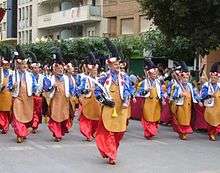
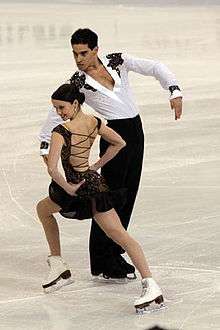
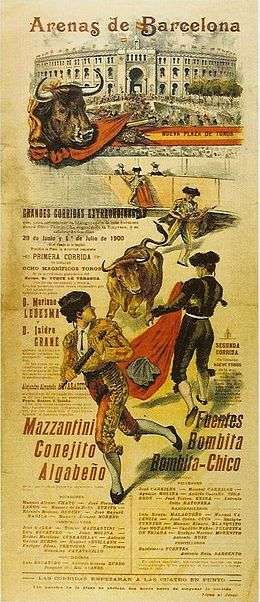
Paso Doble, (meaning double-step in Spanish) is a Spanish light music, with a binary rhythm and moderated movement, probably based in typical Spanish dances of the 16th century. During the 18th century it was incorporated to comedies and was adopted as a regulatory step for the Spanish infantry, with a special feature that makes the troops take the regular step: 120 steps per minute. The music was introduced in bullfights during the 19th century. It is played during the bullfighters' entrance to the ring (paseo) or during the passes (faena) just before the kill. It corresponds to the pasodoble dance (traditional and ballroom).
Paso Doble is a lively style of dance to the duple meter march-like pasodoble music. It is modelled after the sound, drama, and movement of the Spanish and Portuguese bullfight. The traditional version as couple's dance originated in France, and was then adopted in Spain and Portugal. Its original form as a Spanish military march is still interpreted nowadays in the context of the Moor and Christian festivals, in the southeast region of Spain, being the major focus of current pasodoble productions.
Famous bullfighters have been honoured with pasodoble tunes named after them. Other tunes have been inspired by patriotic motifs or local characters.
Famous Spanish pasodobles
- Amparito Roca
- El Beso
- La Entrada
- El gato montés ("Wild Cat") from the opera with the same name
- El Relicario
- Agüero
- España cañí ("Gypsy Spain")
- Islas Canarias named after Canary Islands.
- La Gracia de Dios[1]
- Feria de Manizales (unofficial hymn of the Colombian city, Manizales)
- Manolete, named after Manolete.
- La Morena de mi Copla
- Plaza de las Ventas
- Paquito el Chocolatero. The tune has a dance of its own.
- Sombreros y Mantilles
- Suspiros de España
- Que Viva España
- Valencia
- La Virgen de la Macarena
- Pasodoble hace salir el sol (The Pasodoble makes the sun come up)
Mexican pasodobles
El Piti, El Charro Cárdenas, El 11-81, San Antonio de Triana, Fermincito, Lorenzo Garza, El abuelito, El banderillero, María Caballé, El Berrendito de San Juan, Tarde de toros, Por tapatías, Toros en San Miguel, Rodolfo Gaona, Joselito Huerta, Toros de Llaguno, La Macarenita.
By Agustín Lara: Silverio Pérez, El Novillero, Fermín.
Dance
Traditional
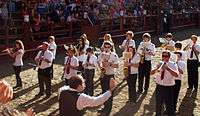
Pasodoble is based on music played at bullfights during the bullfighters' entrance (paseo) or during the passes (faena) just before the kill. The leader of this dance plays the part of the matador. The follower generally plays the part of the matador's cape, but can also represent the shadow of the matador, as well as the flamenco dancer in some figures. The follower never represents the bull, althrough it is commonly thought this way. Its origin dates back to a French military march with the name "Paso Redoble." This was a fast paced march, which is why this is a fast-paced Latin American dance modeled after the Spanish bullfight. Bullfighting was well known around this time.
Ballroom
A significant number of pasodoble songs are variations of España Cañi. The song has breaks or "highlights" in fixed positions in the song (two highlights at syllabus levels, three highlights and a longer song at Open levels). Highlights emphasize music and are more powerful sounding than other parts of the music, usually, dancers have decoration trick and then the position that is to be held to the end of the highlight. Traditionally pasodoble routines are choreographed to match these highlights, as well as the musical phrases. Accordingly, most other ballroom pasodoble tunes are written with similar highlights (those without are simply avoided in most competitions).
Because of its inherently choreographed tradition, ballroom pasodoble for the most part is danced only competitively, almost never socially, or without previously learned routine. This said, in Spain, France, Vietnam, Colombia, Costa Rica and some parts of Germany it is danced socially as a lead (not choreographed) dance. In Venezuela, pasodoble is almost a must-have dance in weddings and big parties, being especially famous by the song "Guitarra Española" by Los Melódicos.
In competitive dance, modern pasodoble is combined with other four dances (samba, cha-cha-cha, rumba and jive) under the banner International Latin. Modern pasodoble dance consists of two dancing parts and one break in between for dancers of class D and of three parts and two breaks in between for dancers of class C, B, A, according to the IDSF classification.[2] Dancers of lower than D-class usually perform only four official dances of Latin-American Program.
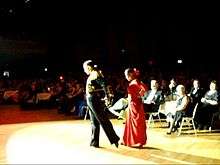
See also
Notes
- ↑ Berenguer Gonzalez, Ramón T. "La Gracia de Dios" Pasodoble Mp3·Authorized Version
- ↑ http://www.worlddancesport.org/
External links
- Amparito Roca Video https://www.youtube.com/watch?v=OcnQqK6-qCc
- Maestro Manuel Lillo 'Plaza de las Ventas' Score